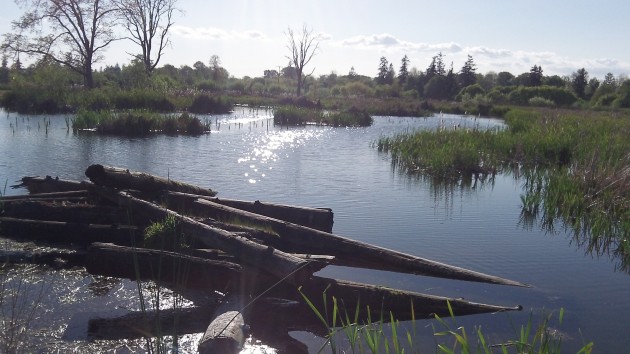On Friday, a fine spring day, I thought I’d check on Albany’s Talking Waters Garden, and where these wetlands adjoin the Millersburg rail yard, I saw this train loaded with logs.
In 2014, log exports from the West Coast, not just from Oregon, dropped 13 percent from the year before, largely because of less demand from China, the Forest Service’s research station in Portland reported last month. Still, West Coast log exports were a big item: 1,706 million board feet worth around $1,310 million.
As I say on the video, I think it would help Oregon’s economy if those logs could be processed in the state rather than being shipped overseas. That’s just my opinion, though, and it is debatable. A 2013 report to the legislature said the situation is complicated, and reduced exports would not necessarily translate into more Oregon jobs.
The softwood logs riding north on the Portland & Western Railroad are from private lands. Logs from federal forests cannot be exported, and in any case relatively few have been harvested in federal forests in the last 30 years or so.
As for the Talking Waters Garden, that was the name originally. Now it’s usually transformed to Talking Water Gardens. Neither one fits, exactly. A garden is one thing that the place is definitely not. Which makes me think: It’s about time the city of Albany prepare a report on how this project has worked out.
It had two goals: Help reduce the late-summer temperature in the Willamette River and absorb certain industrial residues from the already treated wastewater being pumped through it. The city council might want to ask Public Works for some numbers to show how things have been working out. (hh)


I think a report on the impacts to date on this project would be good. Although it might be too soon to have any meaningful data to present some indication of measurements attained to date would be good. I like and even support the concept – in particular since it has the potential to enable Albany to meet state and federal standards pertaining to discharge and run-off waters.
I have always thought it was wrong to export raw logs overseas. Just today I was out at Talking Waters and saw what may be the same train and couldn’t help but notice there were several cars with finished lumber between stretches of raw logs. Quite the contrast.
The value added to our resources by our own processing of them has been a lost opportunity that has cost our domestic economy billions, if not trillions of dollars over the past three decades. We were told then that the Japanese needed their lumber cut to different dimensions and that it was not “practical” or economically feasible to change our mill’s dimension capabilities to accommodate those changes, which I always thought was wrong since US mills changed finished lumber sizes not too many years prior. A “finished” 2×4 once measured 1-5/8″ X 3-5/8″ before the change was made to 1-1/2″ X 3-1/2″. Yankee ingenuity incapable of changing lumber dimensions? I didn’t believe it then and still don’t.
All we did was effectively ship our mill jobs overseas, along with our own natural, renewable resources because it was expedient for big private timber interests. Then the spotted owl came along and the federal government got involved and now Oregon, once the biggest lumber producer in the USA, is a mere shadow of it’s former capability. We no longer have the capacity to process all the timber we harvest. Sad.
Since the train was headed north, that means they are headed towards Teevin Brother’s log yard in Rainer where they will be exported. To Japan I believe. This means they are a very high grade of log, as the Japanese have a higher visual grade of lumber than the large home center grades. Most the logs come from Weyerhaeuser Lands. Interesting fact: the Portland and Western often hauls logs in both directions. Export grade to Teevin Brothers, as well as logs loaded at Teevin Brothers shipped to mills in the Roseburg area. The logs on the cars use to have the name written on them for where they were headed.
Also big kudos for the City of Albany building a great railfanning park. Great views of the turntable can be had (one of only two extant in Oregon (three if you count the old Brooklyn Yard turntable which is currently dis-assembled). And Kudos to the Portland and Western Railroad for not putting up a big fence between the park and the tracks so unobstructed pics and videos can be taken.